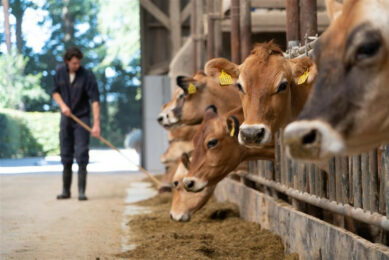Sustainability initiatives: For now and the future

Sustainability is an incredibly important concept these days, due to increasing global awareness of the limited resources to feed our growing population. To demonstrate their care for soil, water, energy and to the public – and to stay competitive as well – many farmer associations, companies and even international consortiums have started sustainability initiatives. Here is a closer look at what is being accomplished through Dairy Sustainability Alliance in the USA and proAction in Canada.
On a global scale, dozens of major food firms such as Nestle, Cargill and Unilever have joined the Sustainable Agriculture Initiative (SAI) to “ensure that the agricultural commodities and ingredients they use are supplied from sustainable sources” through the SAI’s Farmer Sustainability Assessment.

In addition to environmental impact, sustainability programmes for the dairy industry usually include animal care, food safety, biosecurity and more. Some are mandatory and some are voluntary. Some are just for farmers, such as Canada’s proAction initiative, and others incorporate an entire country’s dairy supply chain, such as the UK’s ‘Dairy Roadmap’, the Netherlands’ ‘Sustainable Dairy Chain’ (Duurzame Zuivelketen) and the Australian Dairy Industry Sustainability Framework. Still others encompass a country’s entire food system, such as Origin Green in Ireland.
US programmes
In the USA, more than a decade ago, dairy farmers established the Innovation Center for US Dairy which brings together the entire US dairy community. Within the Center’s purview is a forum called the Dairy Sustainability Alliance (DSA), made up of a broader group of stakeholders, covering 80% of the US dairy industry (through membership in more than 115 organisations such as co-ops), as well as academics and non-governmental organisations.
When asked about the most significant accomplishments of the Center related to sustainability and more, Scott Wallin, vice president of the Center’s industry media relations and issues management, points to its ability to bring leadership from across the value chain together. For example, explains Wallin, in 2008 the Center commissioned a life cycle assessment for fluid milk covering everyone and everything from production to consumer. “The research demonstrates that the US dairy industry contributes approximately 2% of total US GHG emissions,” says Wallin, “the lowest average greenhouse gas (GHG) intensity of milk production globally.” Independent researchers are assessing progress toward achieving the industry’s 2020 GHG emissions reduction goal.
The Innovation Center has also developed several shared best practice programmes such as the ‘FARM’ Environmental Stewardship module, which provides tools and resources for farmers to measure and improve their carbon footprint. The Center has also held the annual US Dairy Sustainability Awards for some years, which recognise excellence in sustainability across the industry spectrum.
In addition, late last year, the Centre launched the US Dairy Stewardship Commitment, a voluntary pledge through which the US dairy community can document and demonstrate its progress in areas like environmental impact. To date, 25 companies representing 67% of US milk production have adopted the Commitment, agreeing to meet, says Wallin, “specific terms of adoption for key priority areas.” To raise awareness and further encourage adoption of the Commitment, the Center is reaching out through the bi-annual meetings of the DSA and US dairy associations, using US dairy trade media, conducting targeted one-on-one outreach to companies, and more.

Environmental sustainability challenges
In terms of the greatest environmental sustainability challenges ahead for the US dairy industry, Wallin explains that earlier this year, the Innovation Center completed an assessment of sustainable dairy priorities across three criteria: importance to stakeholders, significance of impact and ability to influence. The assessment incorporated extensive feedback and involved hundreds of stakeholders over more than ten years. It found that the sustainability factors of most concern were GHG emissions and water stewardship (conservation and quality). “To address these priorities,” says Wallin, “goals and strategies are in development.”
Canadian programmes
Dairy Farmers of Canada (DFC) has gone down a similar sustainability road, creating tools such as Dairy Farms+, which enables the calculation of a farm’s environmental footprint. DFC has also completed a recent industry life cycle assessment, in which GHG emissions generated per unit of Canadian milk produced were found to be comparable to or lower than other countries such as the USA and France.
The star of the Canadian dairy industry’s sustainability focus is the proAction programme, an overall quality assurance initiative. It’s mandatory for all dairy farms, and uses the existing Canadian Quality Milk programme framework and infrastructure.
Implementation of the programme’s six modules (Environment, Milk Quality, Food Safety, Animal Care, Traceability, Biosecurity) are all complete across Canada, except for Biosecurity (currently being implemented) and Environment (to be integrated on farms by September 2021). All modules are implemented in a two-year cycle to give farmers time to learn about and properly apply the requirements, explains Lucie Boileau, DFC director of communications. “The proAction requirements are based on scientific research and best practices,” she notes. “As these components evolve, proAction will adapt and change.”
Independent assessment of module requirements is conducted by various individuals, most of whom were involved in Canada’s dairy industry before proAction. For the Food Safety module for example, assessors were found and trained from existing farm inspectors or advisors. For cattle assessments, DFC contracted Holstein Canada to train their ‘Classifiers’ who were already providing classification services on a large majority of farms across the country.
Biggest challenges
The three biggest challenges in creating/implementing proAction, says Boileau, have been balancing practicality for farmers with credibility of the programme in terms of stakeholders, along with clearly demonstrating the benefit of the programme to farmers. Consultation with farmers, in fact, was present from the very beginning. In line with DFC’s longstanding policy of close collaboration with producers, every single one of them was sent a survey relating to the proposal of the programme. “We also held general farmer meetings in all provinces to present and explain the initiative, as well as to get feedback on how to shape the initiative and its roll-out,” Boileau explains. “There are farmers on every committee (one committee per module of proAction plus an over-arching committee), so when there are discussions about requirements, science and technical issues farmers are always at the table, alongside various industry experts in the field.” She adds that the research that DFC has been investing in for over 25 years “was a tremendous asset” for the development of the programme.

Although the Environment module has yet to be rolled out, Boileau notes that over 70% of Canadian dairy farmers have already completed an environmental farm plan (EFP), a well-established voluntary assessment and action plan that enables farmers of all stripes to address risks such as excess land application of nutrients. (It’s interesting to note that EFP requirements in Alberta, Saskatchewan and Quebec have already been harmonised with those of the SAI’s Farmer Sustainability Assessment, mentioned at the start of this story, with more provinces to follow.)
“We do know that the best practices already implemented with proAction will encourage an increase in efficiencies and decrease our environmental footprint,” Boileau says. “Our life-cycle analysis shows…
Canada has one of the lowest carbon and water footprints in the world for milk production [and]…we continue to progress. In the past five years, producing a litre of milk emits 7% less GHG and uses 6% less water.” For the production of a litre of Canadian milk, carbon emissions have decreased by 27% between 1990 and 2017, she says, with further reductions being achieved every year.
Public relation campaigns
Dairy Farmers of Canada recently launched a campaign to demonstrate sustainability and more, called ‘Dairy Farming Forward.’ It is described as a ‘reframing’ of the Canadian dairy industry, “by highlighting how we are continually embracing innovations on our farms to further the values we place on our environmentally and socially-responsible practices.”
It’s intended to engage Millennials, says Boileau, and indeed, independent research commissioned by DFC already shows that the campaign has caused a shift upwards in millennials’ understanding “of dairy farmers’ commitment toward sustainable farming practices, their care about their animals’ wellbeing and on the environmental impact of their work.” The TV commercial is very much focussed on what dairy farming is like today in Canada, and depicts images of technology use, different weather conditions and diverse task management, all done every day from dawn to dusk.
In the USA in 2017, the Innovation Center launched a large similar media campaign “to grow trust and relevance” in the industry called ‘Undeniably Dairy.’ It reaches the public through avenues such as articles, podcasts, on-farm events and special dinners, all of which “brings the US dairy story to life, engaging consumers to showcase the nutrient-rich profile of their favourite dairy foods, along with a farm-to-table look at the commitment US dairy has to responsible production and positive local community impact.” The campaign’s TV ad, in contrast to the Canadian ad, is a playful look at consumers enjoying a wide range of dairy products.
Initiatives like these in the US and Canada help with positive developments in the dairy sector and highlight how the industry is focusing on the concept of sustainability, with programmes and campaigns the dairy industry can bring accomplishments to the forefront and make the public aware of what challenges are facing the industry and put the innovations in the spotlight.
Join 13,000+ subscribers
Subscribe to our newsletter to stay updated about all the need-to-know content in the dairy sector, two times a week.










